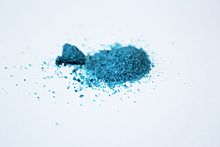|
Patent Blue V
Patent Blue V, also called Food Blue 5, Sulphan Blue, Acid Blue 3, L-Blau 3, C-Blau 20, Patentblau V, Sky Blue, or C.I. 42051, is a sky blue synthetic triphenylmethane dye used as a food coloring.[1] As a food additive, it has E number E131. It is a sodium or calcium salt of [4-(α-(4-diethylaminophenyl)-5-hydroxy- 2,4-disulfophenylmethylidene)-2,5-cyclohexadien-1-ylidene] diethylammonium hydroxide inner salt. Use as dye It is not widely used, but in Europe it can be found in Scotch eggs,[citation needed] certain jelly sweets, blue Curaçao, certain gelatin desserts, among others. An important advantage is the very deep color it produces even at low concentration, a disadvantage is that it fades fairly quickly when exposed to light. In medicine, Patent Blue V is used in lymphangiography and sentinel node biopsy as a dye to color lymph vessels.[2][clarification needed] It is also used in dental disclosing tablets as a stain to show dental plaque on teeth. The color of the dye is pH-dependent. In aqueous solution, its color will vary from a deep blue in alkaline or weakly acidic medium to a yellow–orange in stronger acidic conditions. It is useful as a pH indicator for the range 0.8–3.0.[3] The structure is also redox-sensitive, changing from a reduced yellow form to an oxidized red form in solution. The reduction potential of around 0.77 volts is similar to that of other triphenylmethane dyes. It is usable as a reversible redox indicator in some analytical methods.[4] Because of its pH-dependent color, Patent Blue V was included in chemistry sets from Salter Science in the 1970s and 80s under the name Sky Blue. RegulationPatent Blue V is banned as a food dye in Australia and US, because health officials in these countries suspect that it may cause allergic reactions, with symptoms ranging from itching[5] and nettle rash to nausea, hypotension, and in rare cases anaphylactic shock; it is therefore not recommended in those countries for children. References
|
||||||||||||||||||||||||||||||||||||||||||

